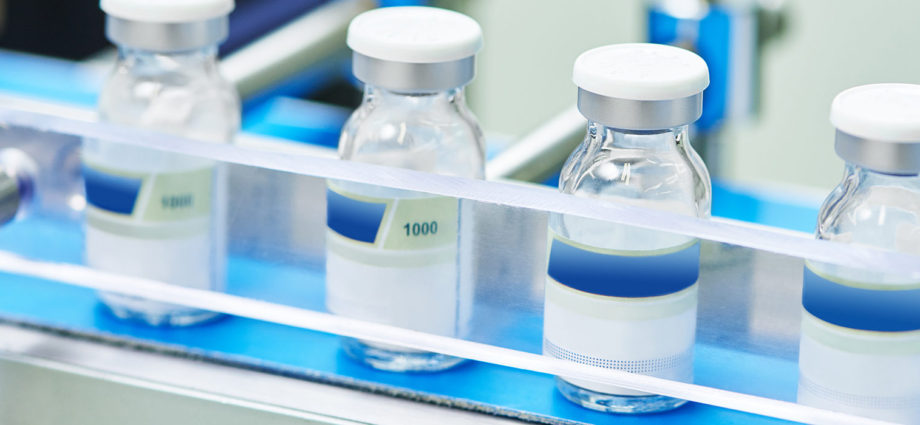Secure Canada’s critical drug supply with domestic manufacturing
Photo by Dmitry Kalinovsky/ Shutterstock
by Saad Ahmed. Originally published on Policy Options
October 29, 2020
The throne speech in September made numerous mentions of the fact that the government has stepped up and signed contracts to domestically produce personal protective equipment (to the tune of $400 million), vaccines ($1 billion) as well as ventilators. Yet, I fear that critical drugs will be forgotten in the shuffle, as the second COVID wave fills up hospitals and causes governments to push reset on their reopening plans.
Allow me to explain: there have been serious, ongoing shortages of medications needed to keep our sickest, most critically ill patients alive. Drug shortages doubled in the first few months of the COVID-19 pandemic, with a survey from May of this year finding that only 3 percent of pharmacists had received their full shipments of drug orders in the first week of May. Many of these medications are used in a variety of settings – from emergency departments to operating rooms to ICUs to hospices – and are critical to the care of some of our sickest patients. These important drugs are given a Tier 3 classification by Health Canada. Their shortages cascade through the system causing a tremendous headache for front-line pharmacists, who can spend up to 25 percent of their working hours dealing with them, or for doctors, such as myself, who scramble to use alternative, often less effective agents. Drug shortages have been found to increase costs for patients, drive up the rates of medication errors, and play a role in greater patient mortality.
Drug shortages have been an unfortunate fact of life in Canada for 10 years now. The causes are many and often opaque. Manufacturing issues are cited most frequently, often stemming from quality issues, and with the COVID-19 pandemic the manufacturing and supply issues have only multiplied. In fact, manufacturing disruptions now account for 62 percent of drug shortages, as per a recent Health Canada communique shared with stakeholders.
Countries like India that manufacture a large portion of the global generic drug supply instituted export restrictions, while others like the US moved to gobble up months of the global supply of promising COVID-19 treatments. India also sources 70 percent of its active pharmaceutical ingredients (APIs) from China, which also had export restrictions on APIs for a time. APIs are the precursors to finished drugs products, and as the name suggests are active ingredients containing the drug’s desired therapeutic properties.
Furthermore, it seems that many of these critical care drugs should have been part of the National Strategic Emergency Stockpile. However, the shortages suggest we did not have enough in the stockpiles. It also seems that funding was cut for the stockpile.
Certainly Health Canada has taken some steps to address fragmented communication about the drug supply chain by both setting up the drugshortages.ca website and chairing committees with producers and medical representatives to act on the shortages of the most essential drugs. The government even ordered urgent importation of drugs, found on the Tier 3 list above.

Yet we have given less thought to a key policy that could build redundancy in our critical drug supply and even create some well-paying jobs for that much needed COVID-19 economic recovery: manufacturing drugs in Canada. Until we domestically produce select, critical medications (and their precursors), we will not be able to secure our drug supply and will be left at the mercy of other countries when the future waves of the pandemic arrive.
It goes without saying that we shouldn’t think about making all of the drugs on the Tier 3 list ourselves. Many could be supplied to us by our closest trading partners and allies. But there will be a select group that can and should be made in Canada – the sort that are chronically short and for which there are few reliable suppliers internationally. And although we have a number of strong, home-grown generic drug manufacturers, we truly only have one facility in the country that can make injectable medications – the sort that are needed in emergencies.
The costs would be minimal in comparison to the sums spent on PPE contracts by the federal government, and likely border on $50 million for a multi-product facility. Several such facilities have been proposed (both of them incidentally in Alberta, a province that could use an economic boost), and a federal commitment will be necessary to solve this issue. In an August open letter to Prime Minister Justin Trudeau signed by the Canadian Medical Association and other medical bodies, we emphasized the need for domestic manufacturing of our own critical medications, along with better stockpiling. Similar to the PPE crisis, we believe that critical drug shortages pose a significant risk to domestic security, thus, amplifying the urgency of this issue.
Subscribe to our newsletter.
That this is happening in a country that was once the insulin factory of the world through its home-grown non-profit drug manufacturer Connaught Labs, which shipped Frederick Banting’s Toronto Insulin around the world, should make us pause and ask: are we truly ready for the second (and third) wave if we haven’t secured our critical drug supply?
This article first appeared on Policy Options and is republished here under a Creative Commons license.

